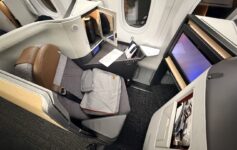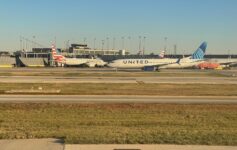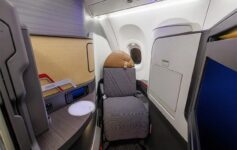American Airlines management has a policy to make flights depart on-time, but it doesn’t make much sense during the COVID-19 pandemic.
If you are considering booking travel or signing up for a new credit card please click here. Both support LiveAndLetsFly.com.
If you haven’t followed us on Facebook or Instagram, add us today.
“D0” Was Initiated With Best Intentions
Passengers, especially business passengers, value on-time arrivals. Leisure travelers will never stop telling the story of how their entire trip was ruined because (blank) airline caused them to miss a connection. In the policy called “D0” American Airlines management was trying to make timeliness a part of its culture. “D0” as in “Departure Zero” was striving to eliminate late flights by pushing every flight to depart exactly on time. Not early, not barely late – exactly when it was supposed to.
Late flights are expensive for the airline and anger customers who may take their future business elsewhere. When D0 was introduced, there were some entry-level complications, but for the most part, everyone wants a flight to leave on time.
Rollout Has Been Poor
There have been many examples prior to COVID-19 of gate agents taking D0 too far. It’s become clear that American Airlines management has made it too important for local gate agents and local management. American’s President, Robert Isom, acknowledged that team members didn’t/don’t have the tools to truly depart as expected on time, every time.
The airline wanted to compete with other carriers who had made on-time performance a priority. At the time of implementation, American Airlines was consistently in the bottom third for US carriers in timely arrivals. What should have been a customer service triumph was instead a customer service problem with some gate agents taking matters too rigidly.
Agents that enforced airline-focused departure rules were simultaneously relied upon for individual circumstances that warranted American expressing more compassion toward its customers.
United took the opposite approach, often holding a door for an inbound passenger that might be less than 15 minutes behind the last flight of the night.
Utterly Moronic During the Pandemic
Getting planes out on time is always important, but with less traffic in the sky and on taxiways, a few minutes here and there are easily made up with the excessive buffer most airlines build into their schedule. When the policy was created, times were good, flights were full, and most importantly, frequent.
Those days are gone. With limited flights, closing the door arbitrarily early can cause the passenger an excessive delay and it may not be free for the airline.
During an excessive delay, if a competing airline has seats available for sale to American, they would likely accommodate their passenger on the competitor. They may also have to absorb the cost of a refund if the trip is “in vain” and the passenger returned to their point of origin. Leaving the door open inside of their ten-minute door closure policy but prior to the flight actually departing costs them “$0.”
Conversely, there’s nearly no penalty for late arriving flights at this point in time, especially minute delays at the destination.
Conclusion
Some would argue that Doug Parker, Robert Isom, and the rest of American Airlines management didn’t really think D0 out when they began the policy. They certainly didn’t evaluate it in practice once it had been implemented by Isom’s own admittance. I respect Mr. Isom for being truthful when questions are answered about the shortcomings of the policy. Simply by admitting it has faults doesn’t mean the company reviewed, approved, or otherwise endorsed the policy’s removal from implementation. But now more than ever, when alternative options are rare and schedules are less exacting, it’s time to retire D0 once and for all.
What do you think? Does D0 have a place in a reduced schedule during the pandemic? Was it so ill-conceived in the first place that it should have never been installed at all?




I mainly fly Delta and it always seems like Delta pads their flight times by an extra 30 minutes so even if the plane departed late, it still arrives on time. In fact, on most of my flights with Delta, it always arrives early at the airport and i’d say half the time upon arrival we have to wait for an available gate!
Perhaps AA needs to pad their flight times too?
I read this article and can’t find a problem. Have there been big problems because of this policy defusing the pandemic that readers have made you aware of? Otherwise this just seem like pure bored conjecture. I’ve in fact experienced the opposite. Two weeks ago I had a tight connection at DFW on American. Though I got to my connection just fine, we left a few minutes late and the pilot announced that we were leaving a few minutes late to “… ensure that some people made the connection”. Also what’s the problem? Give examples. You mention tools the agents didn’t get, you mention agents having to do things. But you don’t really mention what those things are or what tools they could have been given. I read this and walk away not really understanding why you took the time to write this, especially given my recent experience on AA
@Jason – To shed a little more light, you’ll find the next two posts helpful. To shortcut that some, my experience (and that of several fellow passengers) was the opposite of yours. A half full flight closed the door one gate away from my arriving flight due to D0. The agents were aware that three of us would misconnect even though we arrived 7 minutes before true departure and the agents could see our airplane had arrived literally out the window at the next gate over. Because of the pandemic, schedules aren’t what they used to be so we all watched the plane depart exactly on time from the gate and waited 7.5 hours for the next flight which in normal times would have been just an hour or two later. Your experience was contrary to D0 so your example highlights why D0 isn’t a good idea. Had your agents followed D0, you also would have misconnected but because of a thinner schedule, there might not have been another option to get you to your destination. Of my four flights this week two misconnects would have occurred due to American’s operational issues. Luckily the second flight I have missed was delayed as well and I was able to make that flight solely because American was running behind.
Speaking to the resources needed, the linked article expands on the myriad problems with D0 before the pandemic, which are increased during the pandemic with fewer staff, fewer alternatives, and flights that could depart a few minutes late but make it up due to padded schedules. You’re actually supporting United’s policy, a direct contradiction to D0.
Trying to figure out why you used an Alaska Airlines employee and gate counter for an article about American Airlines.
Posting error. Would you settle for a dated American Airlines ticketing agent, rather than gate staff?
Once departing St. Louis in an MD-80 we pushed from a back side gate. During the push I saw a passenger waving in a distressed manner. I had the push crew pull us back to the gate. Called ramp tower and had the agent put on the late connecting passenger. At TWA that is how we did things. Last flight of the day, you need to accommodate the people paying your salary.
A few years ago AA instituted the close the door 10 minutes early policy. Draconian punishment for any Agent for any reason not closing the door. So agents do what they are told. This totally moronic policy has resulted in miss connects and many crew members not getting home. When I see issues at the gate I invent a MX issue that needs to be looked at and that decompresses the issue. So we then get everyone on and the flight departs a couple late and arrives 20 early. But not all pilots are on this page.
The current AA mgt is there to loot shareholder equity. They have wasted a billion dollars on construction of plush and wasteful buildings for management. They have loaded the company with debt. Then they come up with policies that piss off everyone and cause totally needless stress for all.
Parker and Isom, mission accomplished, order another round!
There needs to be a modicum of common sense in the application of these policies/ procedures. Unfortunately, in the midst of many very good ones, there are a few tyrants and martinets running airline departure gates; some of them seem to take pleasure in ‘lording it over’ the traveling, paying customers.
If someone at AA had a few days, they could calculate the effects of D0 (not do do) versus systemwide D-5, D-15, D-15 for last domestic flight of the day, etc.
This has to be one of the least valuable pieces I’ve ever read on airline performance, policies, etc. Every airline’s goal should be a “Do” operating policy – whether we are in a pandemic or normal times. In fact, I’d argue that during a pandemic it’s even MORE critical for airlines to operate on time. An on-time operation will, by definition, mean that passengers and crew members will be spending less time in potentially non-socially distant settings, thereby potentially reducing the likelihood of spreading COVID. I applaud AA for making this the carrier’s goal. And as long as all team members from agents, supervisors, managers, pilots, etc. are empowered to make sensible, selective exceptions when circumstances warrant (like a late-arriving inbound flight with connecting passengers), then this can be a win-win for everyone.
Except that instead of crews spending 15 minutes more in airports and on planes, its passengers spending hours, sometimes overnight in those facilities instead. How, again, is that better from a COVID-19 standpoint?
It’s not. Did you even read the last sentence of my reply? A “Do” operating policy has to be coupled with the right level of empowerment among front line people to do the right thing when needed. That applies whether there is a pandemic or not.
I agree with you, Kyle. Even prior to Covid I feel the policy was absurd. I understand the obsession with on time departures but AA takes it way too far with pushing their gate agents who then take it to another level entirely on their own. It’s especially rampant at DFW where I have arrived 12-13 minutes prior to departure from a connection and the door is closed on the jetway and an agent is nowhere to be found – the plane still sitting there with the jetway attached. There are often five or six of us standing there aimlessly.
A solution is simple.
1. Often the gates are manned by one person and they need to close the door and go down the jetway. Properly staffing a flight is key. If another gate agent is there they can coordinate in that as long as the jetway is attached and there is time to get them on, get them on. Now though, they won’t even try. Or can. For lack of proper gate staffing. This is especially an issue with regional jet flights. Which, in actuality, are the easiest to quickly get someone on five minutes before and the plane out on time.
2. Many of the bookable connections at DFW are asking for trouble. While I try to allow at least an hour there are times I am forced to book a 35 minute connection as it’s the only option showing. Try switching terminals in DFW in that time for a connection. AA needs to retool banks and not be booking flights with less than an hour connection. This would solve probably 60%-70% of all issues.
It has seemed, to me at least, that AA has been a bit more willing to back off of D0 these days. I’ve been on at least two flights that have been delayed, very obviously, for inbound connecting traffic.
Perhaps AA is tacitly conceding that D0 doesn’t make sense in a COVID world.